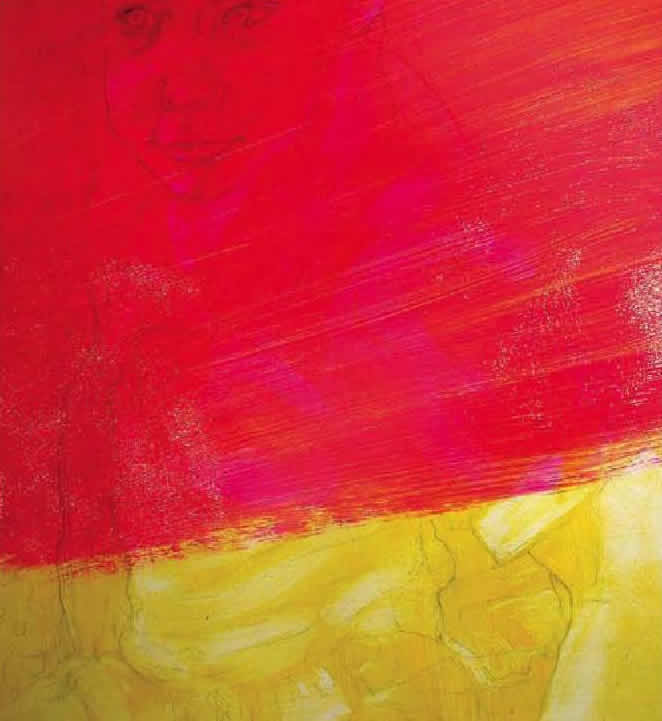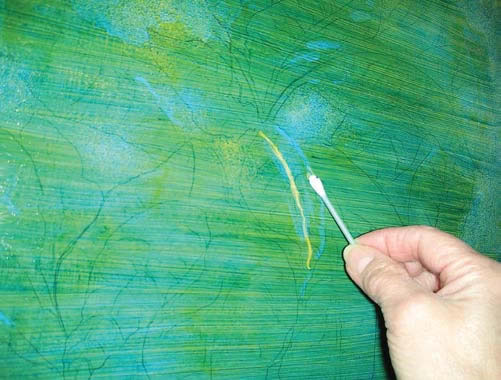The following is an excerpt from the book “Painting with Mixed Media” by Paula Guhin and Geri Greenman. Reprinted with permission of the Publisher “Stackpole Books”.Learn more about Stackpole Books by visiting the link below:http://www.stackpolebooks.com/
Amazin’ Glazin’
Drawn and painted on a humble surface, this project is likely to have a stunning jewel-tone finish. Glazing creates rich, luminous color. It requires the building up of thin, transparent layers of paint.
Tools & Materials
- Heavy brown paper
- Painter’s tape
- Drawing board
- White gesso
- Graphite pencil or graphite transfer paper
- Clear acrylic spray
- Oil paints
- Liquin or other solvent
- Cotton swabs, cotton balls
- Rags
- Palette and palette knife
- Soft, flat oil?acrylic paintbrush
Here’s How
1. Cut heavy brown paper to the size desired. Tape it to a drawing board or other (protected) surface. Paint a coat of acrylic gesso onto the brown paper. If one coat is streaky, add another after the first is dry.

2. When the gesso is dry, sketch directly onto it or transfer a sketch using graphite paper. Avoid erasures, since they might “dirty” the painting. Select a subject (portrait, still life, landscape, or other) that exhibits strong lights and darks. Subject matter with good contrast helps assure success.

3. Spray the drawing with Krylon Crystal Clear or other fixative to prevent smudging.
Always spray aerosols in a well-ventilated area or outdoors. And when you’re working with solvents, wear protective gloves.

4. Mix cadmium yellow oil paint (medium or light cadmium yellow) about 40/60 with Liquin on a palette. Make a good substitute for Liquin by combining stand oil (or linseed oil) with mineral spirits (or turpentine), 40 percent and 60 percent respectively. Use the brush to paint the entire substrate with the first glaze.

5. Lift out highlights wherever needed, dabbing with a rag or cotton balls. Use cotton swabs for tight areas. After the light areas have been picked up, allow the painting to dry before proceeding. Always let the paint dry before adding a new layer of glaze, to prevent the colors from muddying.

6. Next, mix alizarin crimson (or permanent rose) oil paint about 50/50 with Liquin to create a red glaze. (This color, like the blue to come, is less opaque to begin with.) Test the mixture’s translucence on scrap matboard. If it’s suitably thin, paint it over the whole painting. Some parts will turn orangey because this layer, like a colored lens in eyeglasses, visually mixes with the yellow. Lift out all the highlighted areas again—and any sections that you want to be yellow as well.


Areas that will be very dark in the final painting need not be lifted out. Mix things up a bit and save the red layer for last if you like. Rules are made to be broken!

7. When the painting is thoroughly dry again, mix a dark blue oil glaze of ultramarine blue (or pthalo blue) with an equal amount of Liquin. Apply to the entire painting, and start lifting out all the lighter bits again. Wipe less vigorously wherever you want middle values.

In the final painting, the areas of deep shadow are composed of all three glazes.


Leave a Reply